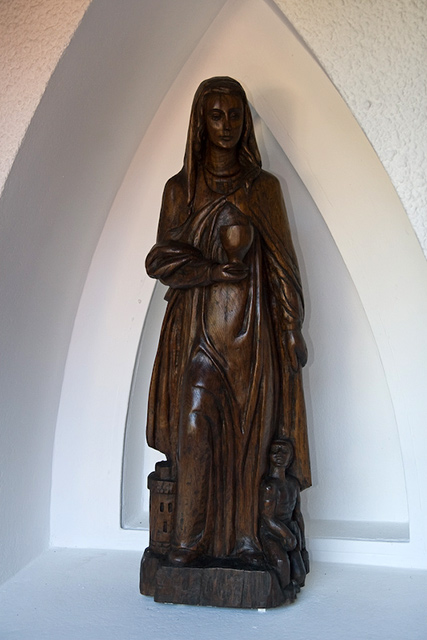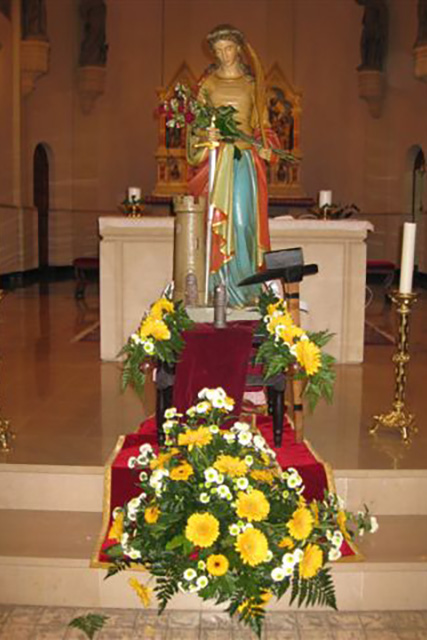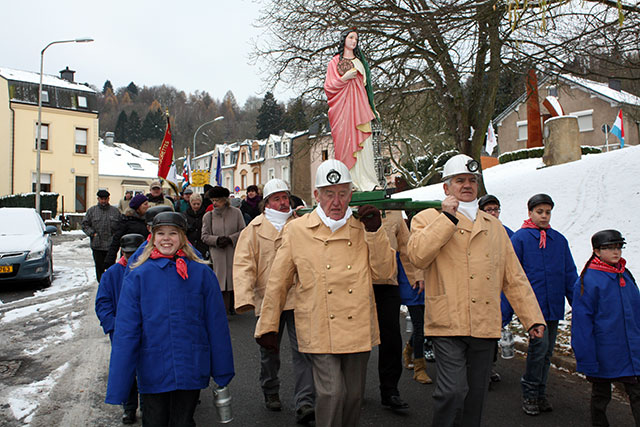Cultural Heritage of the Minett UNESCO Biosphere
The feast of Saint Barbara is celebrated on 4 December. It is a celebration that had and still has great significance in the south of Luxembourg. Saint Barbara is the patron saint of miners and was celebrated by them every year until the end of iron ore mining in our region. However, the tradition did not disappear with the closure of the last mines. To this day, St. Barbara’s Day is celebrated in the traditional way.
Who was Saint Barbara?
According to legend, the protector of miners lived in the Middle East in the 3rd century AD. Instead of marrying, the young woman wanted to dedicate her life to Christ. Her pagan father did not agree with her commitment to Christianity. Despite his sometimes cruel measures – for example, he locked her in a tower for years – Barbara maintained her Christian faith. Her father took her to court and finally beheaded her himself.
The miners venerate her as a patron saint because, according to tradition, she hid in a crevice while fleeing from her father. The crevice is said to have opened miraculously in front of her. In addition to the miners, Barbara is also the patron saint of roofers, firemen and electricians.
 |
 |
 |
A living tradition
More than 40 years have now passed since, with the Thillenberg mine, the last mine in the country was closed for good. But the tradition of St. Barbara’s Day has survived in many southern villages. In many places, a procession is organised on this day, during which a statue of the saint is carried through the town. Firecrackers, as well as a church service and banquet round off the celebrations.
Saint Barbara’s Day, on 4 December, is also used every year to keep alive the memory of the nearly 1500 boys and men, aged between 13 and 78, who lost their lives in the Minett iron ore mines. Without the hard and dangerous work done by the miners between the end of the 19th century and 1981, the foundations of Luxembourg’s current wealth would not have been laid.
Historical context of Barbara Day
Historian Denis Klein, a member of the board of directors of the national mining museum in Rumelange, found the first articles about the custom in luxemburgish newspapers from the 1890s during his research. From then on, at the latest, this day was celebrated in Luxembourg.
In many places, however, it would take until the 1920s or 1930s before the celebration was organised by the mine operators and thus became a “paid holiday” for the miners. In some places, the mine owners only took over this task after the end of the Second World War, according to the historian. From the very beginning, the celebrations included a procession, the firing of firecrackers and a banquet, which often ended in a big party in the mines and for the miners.
According to Denis Klein, it can be assumed that 5 December was not the most productive day of the year in most mines.
Celebrations in the south
Due to the pandemic, there have been fewer celebrations in recent years. Celebrations in honour of St Barbara have nevertheless continued, albeit on a smaller scale, in the communities of the Minett UNESCO Biosphere.
This year, celebrations are almost back to the way they were before the pandemic. On Saturday 3 December, flowers are already being laid at the Barbara Chapel on the former Cockerill Mine site in Ellergronn.
The procession in honour of St Barbara in Rodange will also take place on Saturday. It will start at 4.30 pm. Afterwards, a mass will be held in the church of Rodange and the municipality of Petange invites to a reception.
On Sunday 4 December, there are the traditional celebrations in honour of Saint Barbara in Belvaux and in Esch, at the miners’ monument on Brill Square. In Dudelange, the local section of the OGBL trade union remembers the miners, as it does every year, by laying a wreath in the cemetery. The celebration of Barbara in Lasauvage is larger in scale. The procession will start at 6.45pm, during which a statue of Barbara will be carried from the pétanque field to the entrance of the Doihl mine, where a mass will be read afterwards. The official reception will take place inside the old mine at the end of the celebrations.
In Tétange and Rumelange, the celebrations will already take place on Sunday morning. The festivities start at 9.30 a.m. in Rumelange, where the mass is traditionally celebrated in the mine gallery of the mining museum.
The procession in the municipality of Kayl starts at 9.45 am at the “Schungfabrik” cultural centre in Tétange. From there the procession will go to the cemetery, where flowers will be laid at the grave of a miner. Afterwards a mass will be celebrated and there will be a reception at the “Schungfabrik” in Tétange.
 |
 |
 |
Intangible Cultural Heritage of Humanity?
In addition to the World Heritage Sites, the Memory of the World Programme, the Biosphere Reserves and Geoparks, there is a special UNESCO programme to preserve the planet’s intangible cultural heritage. Luxembourg’s entries on this UNESCO representative list of humanity include the Echternach Spring Procession (since 2010) and the art of the Haupeschbléiser, which was internationally recognised in 2020.
Currently, the procedure to add the tradition of St. Barbara’s Day to the national inventory of intangible cultural heritage in the category of social customs is underway.
Since St. Barbara is also a deeply rooted tradition in other countries, such as Poland or Austria, an international application to add St. Barbara’s Day to the UNESCO Representative List of Humanity could soon be submitted.



